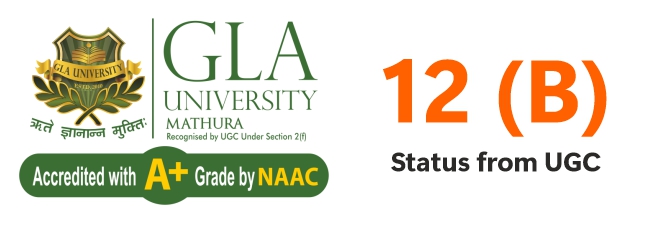“Education is the most powerful weapon which can be used to change the world”. GLA University concurs with this well-quoted thought by Mr Nelson Mandela and wants to live and share the proud moment accredited by NAAC in the form of an A+ rating with an impeccable score of 3.46. Another feather in the cap is its recognition as India’s No 1 university amongst all state and private universities in the A+ category. Also, this time GLA University is just 0.5 points away from a NAAC A++ rating but is fully charged up to achieve this in the near future.
NAAC A+ is indeed a great achievement for GLA University that cannot be expressed in words. Students and faculty of GLA have all the right to celebrate this victory and share this delightful feeling with their friends and relatives. This excellent certification by NAAC would act as a morale booster for all the members of GLA University.
Origin of NAAC
In 1986, the National Policy in Education has shown its concern for promoting quality education in India’s higher institutions and thus gave its recommendations to establish an autonomous body that can keep a check on it. As an outcome, the National Assessment and Accreditation Council or NAAC has been set up in the year 1994 with its headquarters in Bengaluru. Funded by UGC – the University Grants Commission, this well-esteemed organization is involved in the accreditation of higher education institutions in India.
NAAC has a General Council and Executive Committee of educational administrators, senior academicians and policymakers from various parts of the Indian higher education system. The major vision of NAAC is to keep quality assurance and transparency in its processes.
Objectives of NAAC
The major concern of NAAC or the National Assessment and Accreditation Council is to spread awareness among institutions to render quality education. Let’s discourse about its prime objectives –
- To ensure assessment and accreditation of higher education institutions or units periodically
- To promote self-evaluation, innovations and accountability in higher education
- To make institutions realize the significance of training programs and other academic-related events and seminars
- To maintain a good academic environment inside the institutions and encourage quality learning and research work
- To ensure the best quality evaluation and accreditation by joining hands with other stakeholders of higher education
What exactly NAAC does?
NAAC is involved in the procedure of assessment and accreditation of higher educational institutions being assessed. The process followed is quite seamless and includes multiple stages like a team of assessors visiting the campus, examining performance on the basis of multiple parameters (as discussed below) and drafting the report of the institutions before leaving. Also, there might be certain institutions that opt for grievance redressal if not appeased with the accreditation.
Significance of NAAC accreditation
If we flip the pages of our old education system, we may find many loopholes in terms of the standard curriculum, quality of teaching, knowledge enhancement and skill development of the students and so on. NAAC accreditation, at present, is emerged as a life saviour for both students as well as institutions. This grading system has improvised the level of education to a great extent which lays a huge impact on the overall development of the students.
NAAC accreditation segregates quality institutions from average or low-grade colleges or universities making it easier for the students to select the one best in infrastructure, amenities, resources, faculty, quality of teaching and research.
On the other side, it provides a sense of credibility and confidence to the best institutions which in turn increases their admissions.
Steps involved in NAAC Process
NAAC accreditation is a seamless process where a team of assessors has an on-site involvement in the procedure containing two crucial steps as given below –
Step 1
Higher Educational Institutions interested in NAAC accreditation need to submit SSR or Self Study Report and IIQA or an Institutional Information for Quality Assessment to NAAC which further evaluates the same.
Step 2
This step of assessment depends upon various factors right from the number of research journals in the library to the faculty and the number of international publications produced by the college, institute or university.
An on-spot grading system is quite important as it contains 30% weightage of the overall assessment process.
NAAC 7-Point Grading System
NAAC has identified seven assessment criteria on the basis of which it provides accreditation to higher education institutions that include universities, affiliated colleges and autonomous institutions. Let’s get insights into all of them one by one –
Curricular Aspects
The major aspects that come under this criterion include Curriculum design and development, Academic flexibility, Curriculum planning and implementation, feedback system and Curriculum enrichment.
Teaching-Learning and Evaluation
This criterion lays emphasis on academic activities of the institution like teaching-learning processes, quality of teaching, type of faculty, students’ overall performance, evaluation processes, students’ enrolment, etc.
Research, Consultancy and Extension
The key parameters involved in this criterion are the promotion of research, research facilities, and resource mobilization for research, consultancy, research publications, collaborations, extension-related activities and awards and so on.
Infrastructure and Learning Resources
The considerable points in this criterion include the infrastructure and amenities that students get inside the campus like play areas, hostels, Wi-Fi, medical care units, labs, library, IT set-up, advanced learning resources, management and maintenance of resources and facilities, etc.
Student Support and Progression
To meet this criterion, the institutions must pay heed to students’ progression, mentoring and support and their activities and participation in various events.
Governance, leadership and management
Here, the assessment is based on strategies that institutions make for development and deployment, internal quality assurance, faculty empowerment, resource mobilization and financial management.
Innovations and best practices
This criterion is basically designed to see the approach of HEIs towards energy conservation, making campus eco-friendly campus, creative ideas devised within the institution for a better tomorrow and so on.
A table containing criteria and their weightage
Below tabulated is the weightage of each criterion for universities, autonomous colleges and affiliated UG and PG colleges –
Criteria-wise distribution of weightage
| Criteria | Universities | Autonomous Colleges | Affiliated UG Colleges | Affiliated PG Colleges |
| Curricular Aspects | 150 | 150 | 100 | 100 |
| Teaching-learning and Evaluation | 200 | 300 | 350 | 350 |
| Research, Innovations and Extension | 250 | 150 | 110 | 120 |
| Infrastructure and Learning Resources | 100 | 100 | 100 | 100 |
| Student Support and Progression | 100 | 100 | 140 | 130 |
| Governance, Management and Leadership | 100 | 100 | 100 | 100 |
| Institutional Values and Best Practices | 100 | 100 | 100 | 100 |
All about NAAC Grading System
Transparency is something that lies at the top when it comes to NAAC Grading System. NAAC has created an intricate system of grading and assessment for universities, colleges and other higher educational institutions. Let’s understand this complex framework of rating in detail –
Institutional Grading System
In this rating system, institutions are assessed on the basis of seven criteria given by NAAC as mentioned above.
CGPA or cumulative grade point average grading system
NAAC grading system contains institutional CGPA and letter grades. CGPA refers to the score of a particular institution in the evaluation process. The letter grade implies the quality and performance of the institution that measures the accreditation status.
CGPA Calculation
The evaluation of institutional cumulative grade point average depends upon the scores attained by the higher education institutions from the below-given sources –
- System Generated Scores of the quantitative metrics that have the highest weightage of 70% in assessment
- Scores attained from the qualitative assessment
- Report submitted by the peer team during the visit
- Scores collected in the student satisfaction survey
There is a system-generated process that makes the calculation on a five-point scale.
Final rating
The institution will be bestowed a final rating on a seven-point scale which is in alignment with seven-letter grades that reflect the accreditation status of the higher education institutions or HEIs. Below given table contains the range of CGPA rating, letter grade and accreditation status as formulated by NAAC –
CGPA, letter grade and accreditation status
| CGPA Range | Letter Grade | Status |
| 3.51-4.00 | A++ | Accredited |
| 3.26-3.50 | A+ | Accredited |
| 3.01-3.25 | A | Accredited |
| 2.76-3.00 | B++ | Accredited |
| 2.51-2.75 | B+ | Accredited |
| 2.01-2.50 | B | Accredited |
| 1.51-2.00 | C | Accredited |
| ≤ 1.50 | D | Not Accredited |
Does NAAC allow reassessment?
Though there is hardly any room for reassessment after the final rating of NAAC as the process is seamless and transparent, institutions can apply for reassessment after one year of NAAC accreditation but not after three years. The fee details and other related information would be as per the current policies of Assessment and Accreditation. No reimbursement or fee waiver is applicable for the institutions coming forward for re-assessment.
Paramarsh Scheme to monitor the NAAC accreditation process
Paramarsh scheme is proposed to be launched for keeping an eye on NAAC accreditation procedures to encourage 100% transparency in the grading system. Apart from promoting the flow of knowledge, information and opportunities for faculty and research development, this scheme would majorly look after the accreditation culture as a whole.
Overall NAAC lays emphasis on improving the quality of education by providing accreditation to higher education institutions. GLA University will keep on maximizing the learning outcomes of the students by applying for NAAC accreditation every time. Aspirants should also remember one thing – apart from checking the NAAC grade, they should also know the NAAC score of the university before applying for admission. It will help them make a wise choice and choose the right university.














